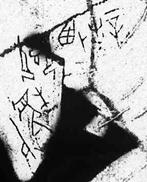
A Unique Shang Dynasty Group Writing
(首發)
Adam Schwartz石亞當
芝加哥大學
On the left half of a turtle carapace discovered from Huayuanzhuang East (HYZ 332) there is the inscription which Yao Xuan’s transcription reads as:
辛未卜:西鄉(向?饗?)[![]() ]二
]二
There are two problems with this. The first is her indecision about how to read 鄉, either as a loan for xiang向 ‘to face, head (in a direction)’, or as the ancestral form of xiang饗 ‘to feast’; the second is the divination coda which she leaves undetermined, preferring to put her faith in the facsimile form rendered by Liu Yiman and Cao Dingyun.
From the rubbing (plate 1), however, we can note two problems with Liu and Cao’s hand-copy. One, the incorrect rendering of a line that looks like an underscore running from the bottom of the middle graph down to the bottom of the ‘left hand holding a stick’ . Two, the non-inclusion of the top part of a second ‘tree’ which can still be seen (fig. 1).
Actually, is a group writing of what amounts to three words: the first is the compound pictograph
is a group writing of what amounts to three words: the first is the compound pictograph ![]() which, as indicated by Qiu Xigui (1992: 351), can be read as two words, bao hu暴虎 ‘to battle a tiger’[1]. The third is then
which, as indicated by Qiu Xigui (1992: 351), can be read as two words, bao hu暴虎 ‘to battle a tiger’[1]. The third is then ![]() , a word so far restricted for use in nonroyal oracular records with a meaning of ‘distress, (or more generally) unlucky’. The scribe’s ingenuity endomorphicizes a shorthand form of “女” into the tiger’s body.
, a word so far restricted for use in nonroyal oracular records with a meaning of ‘distress, (or more generally) unlucky’. The scribe’s ingenuity endomorphicizes a shorthand form of “女” into the tiger’s body.
Once we know that the inscription concerns hunting it can be adduced that 鄉ought to be read as the direction word向, not饗. This reading can be supported by the use of the phrase向![]() on HYZ 381:
on HYZ 381:
戊戌夕卜:![]() 己,子其[逐],从
己,子其[逐],从![]() 人鄉(向)
人鄉(向)![]() ,冓(遘)。
,冓(遘)。
In sum, the correct transcription of HYZ 332 should be:
辛未卜:西鄉(向)![]() ,
,![]() 。二
。二


Plate 1: HYZ 332 Fig. 1: 第二個 “木”
2011-10-29, 1:18am
在上海老廟寫成
[1] Note that while Qiu’s reading was accepted by Yao Xuan (2006: 75-78) , there remains the
possibility that this compound pictograph should to be read as a different word altogether, and not as a variant spelling of ![]() which Qiu originally suggested. Liu and Cao’s commentary to HYZ 381 (cited in the body of the paper below) posits that the original meaning of the word derives from its graphic depiction of “chasing off a tiger驅虎”: “其本意應為驅虎, 但在此應為名詞, 即被驅趕之虎” (p. 1710). Regardless of whether it means to ‘battle a tiger搏虎’ or ‘to chase off a tiger驅虎’, based on principles of Shang writing the likelihood still exists that it should be read as two words. It is for this reason that I term the HYZ 332 form a ‘group writing’ and not a conventional ligature (合文).
which Qiu originally suggested. Liu and Cao’s commentary to HYZ 381 (cited in the body of the paper below) posits that the original meaning of the word derives from its graphic depiction of “chasing off a tiger驅虎”: “其本意應為驅虎, 但在此應為名詞, 即被驅趕之虎” (p. 1710). Regardless of whether it means to ‘battle a tiger搏虎’ or ‘to chase off a tiger驅虎’, based on principles of Shang writing the likelihood still exists that it should be read as two words. It is for this reason that I term the HYZ 332 form a ‘group writing’ and not a conventional ligature (合文).
本文收稿日期為2011年11月2日。
本文發佈日期為2011年11月4日。
点击下载附件: 0974石亞當:A Unique Shang Dynasty Group Writing
0974石亞當:A Unique Shang Dynasty Group Writing
-

wuwen 在 2011/11/4 13:43:38 评价道:第1楼
亞當兄好!《花東》332可加《花東》534,綴合後得到完整一字:
 (1)辛未卜:西鄉(向)~。用。 《花東》332+《花東》534[花東類]
(1)辛未卜:西鄉(向)~。用。 《花東》332+《花東》534[花東類]可知該字的確有第二個“木”,並且還有第三個。該字亦見於舊有卜辭:
 (2)…遘,有鹿。 〇 …~,弗擒。 《合》28335[無名一類]
(2)…遘,有鹿。 〇 …~,弗擒。 《合》28335[無名一類] (3)…~。在二月。 《合》37891[黃類]
(3)…~。在二月。 《合》37891[黃類]由於2、3兩形俱殘,以前的工具書等摹錄多有不確(如《甲骨文編》第3638號,第716頁)。現在有花東字形,則可知其全貌。
提供以上資料,僅供參考。
,
Copyright 2008-2018复旦大学出土文献与古文字研究中心版权所有 沪ICP备10035774号 地址:复旦大学光华楼西主楼27楼 邮编:200433
感谢上海屹超信息技术有限公司提供技术支持
總訪問量:952784